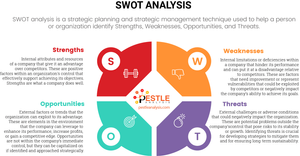Easy SWOT analysis examples to help you understand the strategic planning tool better and quicker.
For big and small businesses, it is important to analyze all situations carefully before making any decision. That way, there will be fewer chances of making mistakes and designing strategies that won’t work.
To help these businesses, several analytical tools are available, one of them being the SWOT Analysis. However, before you start using a SWOT Analysis template and check out SWOT analysis examples, it is important to understand what this analytical method is all about.
What is SWOT Analysis?
SWOT analysis involves identifying internal factors like strengths and weaknesses of a business along with external factors like opportunities and threats. SWOT analysis is conducted for gaining insight into where a business stands today and where it may stand in the future as a result of using the identified strengths and opportunities for overcoming weaknesses and combating threats. SWOT examples can help you understand how to run an effective SWOT analysis by giving you an idea of how elements in this analysis are sorted into their respective categories.
SWOT Analysis Template Factors
- Strengths of a business are its features that enable it to operate better than its competitors. For a business, strengths could be a variety of things including vast experience, reputation or goodwill, knowledge, innovation, and customer trust and satisfaction. However, when considering strengths, make sure you consider them from every point of view including that of your suppliers, customers and your business. When exploring your strengths, answer questions like why do our clients prefer to work with us rather than anybody else or why our consumers prefer to buy our products? What is it about your product offerings, which your competitor’s products and services do not entail? Does your team work better than others or is it your unique services, products and processes?
- The second factor in SWOT examples is the weaknesses all businesses tend to have a few, no matter how big or small they are. You don’t necessarily have to take weaknesses negatively. Rather, think of them as avenues for improvement. Therefore, be honest when you are writing down your weaknesses. Analyse closely what it is that your business is currently lacking. Is it new products or services, or failure to keep up with evolving technology and developments in your industry? Do you think your team’s productivity is lower than that of your competitors? To make it more accurate, try to get input from your suppliers and customers. You can also use social media for getting feedback from your customers.
- The third factor in SWOT examples is the opportunities a business can avail at present. Many businesses fail because they either fail to recognize or capitalize on the opportunities which lie ahead for them. Possible opportunities for businesses include changes in trends or customer preferences, seasonal changes, a need-solution gap in the market and changes in the government regulations or policies. Using effective marketing techniques to boost your profitability can also act as an opportunity for many small businesses.
- Threats are the last factor in the SWOT examples, which include elements that can adversely affect your business. Threats can be both internal and external to the business. External threats to businesses can include changing trends, a new competitor who may have entered the market, and evolving technology. Businesses may also face internal threats such as a lack of skills, which are necessary to run the business, and insufficient resources.
This assessment technique has a remarkable track record of success, providing almost accurate and extremely helpful insights to a business’ resources. To help you understand better how it works, it may be a good idea to look at some SWOT Analysis examples.
SWOT Analysis Examples
Here is an example of a SWOT Analysis table that was actually carried out by Dell in the mid 90’s to analyze its market position:
|
Strengths: |
Weaknesses: |
|
|
|
Opportunities: |
Threats: |
|
|
For more general SWOT Analysis examples, here is one with some general entries. You can let the factors relevant to your situation stay while removing and adding accordingly:
|
Strengths: |
Weaknesses: |
|
|
|
Opportunities: |
Threats: |
|
|
With these SWOT Analysis examples, you can easily understand how you can use this to analyze a business situation in a comprehensive way. After conducting a SWOT analysis, you can determine whether a new venture have enough positives in its favor to be pursued.


